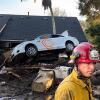What Happens After a Mudflow Destroys Your Home? The Hidden Costs of Rebuilding Post-Fire

California is once again facing a horrifying wildfire season. The Dixie Fire threatens to break the record set just last year by the August Complex Fire, the gigafire that burned over one million acres. Thirteen of the top twenty most destructive wildfires in California’s history have occurred since 2017, burning over 40,000 structures. We now see massive and destructive wildfires year after year, with seemingly daily reports of one fire’s rapid spread overnight or another barely held back by a combination of tremendous resources and lucky weather. And even when the fire is fully suppressed, the danger may not be over.
Intense rains after a fire can precipitate mudslides and debris flows that can bury homes or rip them from their foundations. Shortly after the 2018 Thomas Fire, the Montecito mudslides destroyed over 400 homes and killed 23 people, with two still missing. This week’s “The West on Fire” episode explores what happened there.

Another challenge of the post-fire landscape is rebuilding. In the wake of fires and mudflows tragedies, homeowners must make hard and expensive decisions. Should we stay or just sell the property and leave? Will life ever be normal again? Where will we live in the meantime? How much will this cost, and how long will it take?
Those who decide to stay and rebuild can face an unexpected barrier to starting the process: just figuring out where your property begins and ends. Property surveys determine a property’s legal boundary lines, which can subsequently define where, what, or even how you can build. Surveyors rely on historical records and legwork, since many old deeds that define property boundaries were based on distance from local landmarks which may have changed over the years.
Property surveying can become a major barrier to construction when homes move after a debris flow or when property markers disappear after a fire. So many homes had physically moved after the Montecito mudslide that rebuilding couldn’t begin until surveyors had identified where the property lines fell.
The 2018 Camp Fire destroyed 11,000 homes and left just 7% of residential structures standing in the Town of Paradise. Today, homeowners must have completed a professional property survey prior to building to officially record property lines and ensure adequate setbacks based on municipal codes. But Paradise didn’t require property surveys before the fire, meaning that people relied on old, frequently incorrect, descriptions of their property boundaries, like wooden fences or distance from a large boulder. According to Charles Brooks from the Rebuild Paradise Foundation, many Paradise residents—himself included—only learned that they were inadvertently claiming their neighbor’s property as their own after conducting a post-fire survey.

As Brooks explained, “Property surveying has posed a huge financial burden for the community as a survey can range from $900 to $8,000 depending on whether that property had a previous record of survey.” Though $8,000 is a tiny fraction of the estimated $336,000 needed to rebuild a home in Paradise, smaller costs from steps like surveying still add up, especially in cases when homeowners have insufficient or no fire insurance. And while Montecito is a wealthy town, Paradise is primarily a working-class community with a lower median household income than the average in California.
“This additional cost, when combined with several other pre-construction costs, can and has limited households’ ability to rebuild,” Brooks continued. “We have responded by offering grants, mapping and other resources to help offset costs associated with these challenges.” The foundation created an online map depicting each property with details on the surveying company responsible for identifying property corners. Knowing which company has already identified the corners on the neighboring property means that those corners don’t need to be surveyed again. Neighboring homeowners could band together by working with the same company to reduce some of the costs.

Of course, once preliminary steps like surveying are completed, homeowners still face monumental challenges to rebuilding. Wildfires have pushed material costs up significantly, with lumber prices rising up to 50%. When fires destroy hundreds or thousands of homes nearby, contractors and construction companies quickly arrive to begin the rebuilding process, but there are simply not enough qualified construction workers available. Desperate homeowners have been duped by fraudulent contractors or those who overpromise and underdeliver, such as the Chiaramonte Construction & Plumbing Company which assured homeowners after the 2017 Tubbs Fire in Sonoma County that they could have custom-designed homes for minimal pricing. Instead, prosecutors have filed nearly 60 felony counts for theft and fraud against the construction company when it failed to begin construction on dozens of its contracts.

Construction after a fire is frequently more expensive than expected, forcing people to reimagine their homes and try to save costs when they can. In both Paradise and Santa Rosa, concerns around the costs to build to wildfire-resistant construction standards prompted the city council to vote against ordinances designed to ensure greater fire protection for rebuilt homes.
It isn’t just homeowners who experience these heightened costs. Homeowners must have fire insurance to have a mortgage, whereas renters are not required to have insurance in California, and thereby can be left with no recourse when they lose their shelter and belongings. Price gouging after a wildfire can also make housing costs prohibitive for renters, particularly for those without the backing of an insurance company. The destruction from fires and associated debris flows have exacerbated already stressed housing markets in California. Greater demand and smaller supply for housing have increased home prices from Paradise to Berkeley. Meanwhile, fire insurance continues to grow increasingly unaffordable in California. Without serious changes to how we as a state manage our wildfire risks, Californians are likely to face hefty bills on everything from property surveying to rebuilding to insurance for years to come.











